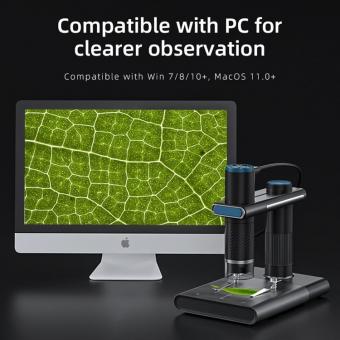Can Viruses Be Seen Under A Microscope ?
Yes, viruses can be seen under a microscope. However, they are much smaller than bacteria and other microorganisms, so a special type of microscope called an electron microscope is needed to see them. The electron microscope uses a beam of electrons instead of light to magnify the virus particles, allowing them to be seen in great detail. This technology has been instrumental in advancing our understanding of viruses and their structure, which has led to the development of vaccines and treatments for many viral diseases.
1、 Viral morphology and structure
Yes, viruses can be seen under a microscope. However, they are much smaller than bacteria and other microorganisms, which makes them difficult to observe using a light microscope. Instead, electron microscopes are used to visualize viruses. These microscopes use beams of electrons to create highly detailed images of the virus particles.
Viral morphology and structure can vary greatly depending on the type of virus. Generally, viruses consist of a nucleic acid core (either DNA or RNA) surrounded by a protein coat called a capsid. Some viruses also have an outer envelope made of lipids that surrounds the capsid. The shape of the capsid can be either helical or icosahedral, and some viruses have complex structures that include tail fibers or spikes.
Recent advances in cryo-electron microscopy have allowed scientists to study the structure of viruses in even greater detail. This technique involves rapidly freezing virus particles in a thin layer of ice, which preserves their structure. The frozen particles are then imaged using an electron microscope, and the resulting images are used to create 3D models of the virus structure.
Understanding the morphology and structure of viruses is important for developing treatments and vaccines. By studying the structure of a virus, scientists can identify potential targets for antiviral drugs or design vaccines that stimulate the immune system to recognize and attack the virus.

2、 Viral replication and life cycle
Yes, viruses can be seen under a microscope. However, they are much smaller than bacteria and other microorganisms, making them difficult to visualize using traditional light microscopes. Instead, electron microscopes are used to observe viruses. These microscopes use beams of electrons to create highly detailed images of the virus particles.
Viral replication and life cycle involve several stages, including attachment, penetration, uncoating, replication, assembly, and release. During the attachment stage, the virus attaches to the host cell's surface using specific receptors. Once attached, the virus penetrates the host cell and releases its genetic material. The genetic material then takes over the host cell's machinery, replicating itself and producing new virus particles. These particles then assemble and are released from the host cell, ready to infect new cells.
Recent research has shed light on the complex mechanisms involved in viral replication and life cycle. For example, scientists have discovered that some viruses can manipulate the host cell's immune system to evade detection and destruction. Additionally, new antiviral therapies are being developed that target specific stages of the viral life cycle, such as blocking viral attachment or replication.
In conclusion, while viruses are difficult to visualize using traditional light microscopes, electron microscopes can be used to observe their structure and morphology. Understanding the complex mechanisms involved in viral replication and life cycle is crucial for developing effective treatments and preventing the spread of viral infections.

3、 Viral classification and taxonomy
Yes, viruses can be seen under a microscope. However, they are much smaller than bacteria and other microorganisms, and therefore require specialized equipment and techniques to be visualized. The first virus to be observed under a microscope was the tobacco mosaic virus in 1935, using an electron microscope.
Viral classification and taxonomy is the process of organizing viruses into groups based on their characteristics and evolutionary relationships. This is an ongoing process, as new viruses are constantly being discovered and studied. Currently, viruses are classified based on their genetic material (DNA or RNA), their shape, and other characteristics such as their mode of transmission and host range.
Recent advances in technology, such as next-generation sequencing and metagenomics, have greatly expanded our understanding of viral diversity and evolution. These techniques allow for the detection and characterization of viruses that were previously unknown or difficult to study. As a result, the field of viral classification and taxonomy is constantly evolving and adapting to new discoveries.
In summary, viruses can be seen under a microscope, and their classification and taxonomy is an ongoing process that is influenced by new discoveries and technological advances.

4、 Viral pathogenesis and host response
Yes, viruses can be seen under a microscope. In fact, the invention of the electron microscope in the 1930s allowed for the first visualization of viruses. Prior to this, viruses were too small to be seen with traditional light microscopes. Electron microscopy allows for the visualization of viruses at a much higher resolution, allowing for the observation of their structure and morphology.
However, it is important to note that not all viruses can be seen under a microscope. Some viruses are too small to be visualized even with electron microscopy. Additionally, some viruses may be difficult to visualize due to their shape or the way they interact with host cells.
In terms of viral pathogenesis and host response, visualization of viruses under a microscope can provide important insights into the mechanisms of viral infection and replication. For example, electron microscopy has been used to study the structure of the SARS-CoV-2 virus responsible for the COVID-19 pandemic. This has allowed researchers to better understand how the virus interacts with host cells and how it replicates within the body.
Overall, while not all viruses can be seen under a microscope, electron microscopy has revolutionized our ability to visualize and study viruses. This has led to important insights into viral pathogenesis and host response, and will continue to be an important tool in the fight against viral diseases.







































